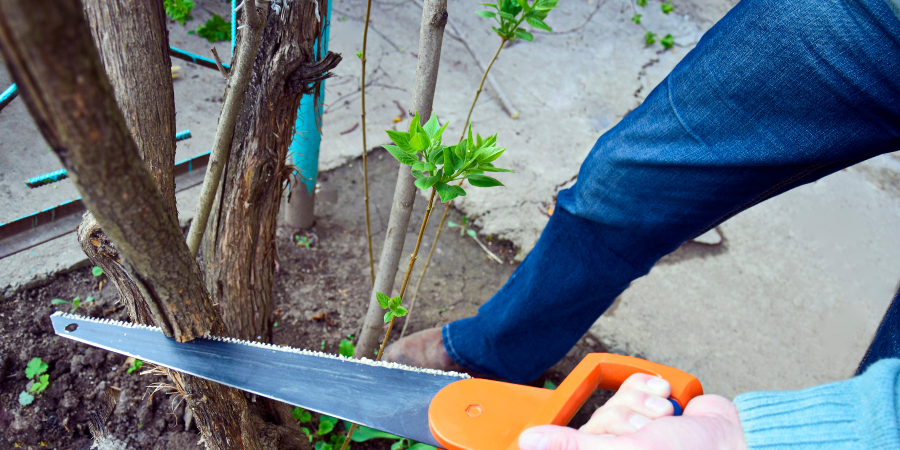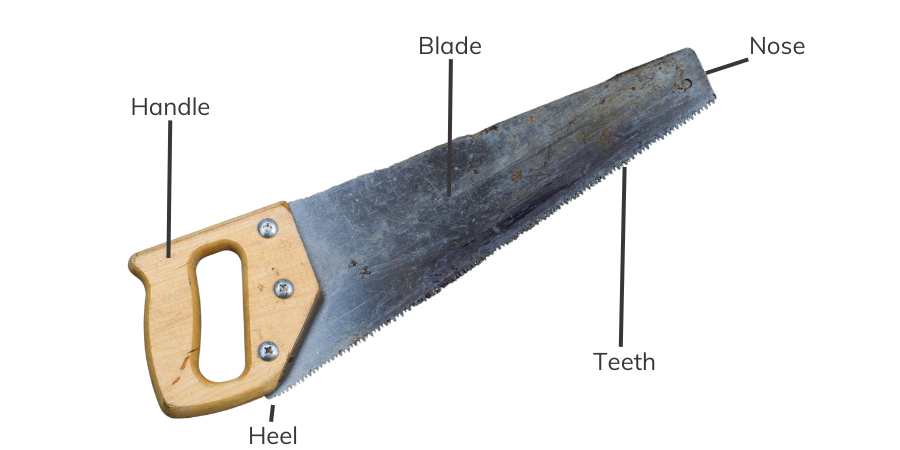How To Use A Hand Saw

If you have ever wondered how to use a hand saw, don't worry - it's not difficult. We'll explain everything you need to know in this quick guide.
NOTE: This is for manual hand saws and nothing power related. For extremely precise cuts, you might need something like a miter saw.
Table of Contents
How To Use A Hand Saw 101

Cutting a piece of wood should not require excessive force. Yes, you will have to apply some pressure but the idea is to let the sharp teeth cut the wood. You shouldn't have to force the hand saw teeth through the wood but rather let the wood cut the log.
Also be sure to grab some safety glasses. Cutting through wood can be dangerous and you want to take all the required safety precautions. Hand saws are a sharp tool so be careful. Take the blade guard off your saw, clear your work surface and let's get to work.
Holding The Saw
The typical hand saw (like the one in the picture above) has two main parts: the handle and the blade. Hold the hand grip so that the side of the saw blade with the teeth is facing down.
We hope this makes sense as you wouldn't be able to cut wood with a flat side. There are some more parts of a hand saw, but we'll cover that in another article. For now, you only need to know how to hold the saw in order to use it.
Securing The Wood
Once you know how to hold the hand saw, secure the wood in place with either a clamp or with a little bit of pressure. If you are using power tools, you'll need to secure the wood in place properly to avoid injury. We are talking about hand saws here so just make sure the wood isn't moving around as you cut.
Making The First Cut
Now that you know how to hold the hand saw, it's time to make the first cut. If you are cutting a piece of construction wood, like a 2 x 4, or if you are cutting a log - you need to make a first notch. How do you maker the first notch? Simple.
Hold the saw blade at an angle against the wood. Only a few teeth should be touching. Start sawing. Slowly move the blade against the wood in a back and forth, push stroke motion. Push, pull. Push, pull. Over and over. Once you cut in deep enough, you have the notch you need to cut through the wood.
Some of you are probably asking, how do you know where to make that notch? That depends on you! How much length do you need? Use a ruler, straight edge or tape measure and measure out the amount of wood you need for your project. Mark it with a pencil. That pencil line is where you start your cut line.
Note: Hand Saws aren't too dangerous, but there are some safety precautions you need to take to avoid injury [1].
Cutting Through The Wood
Okay, now that we have that initial notch, keep cutting until you are able to lay the saw flat so the blade extends across the wood. Again, you shouldn't have to force your way through the wood but with a smooth, back and forth motion, you should be able to slowly but surely cut in a straight line through the wood.
Of course, this will depend of what type of hand saw you are using. Bow saws tend to cut faster than standard hand saws. Sharper teeth will definitely cut smoother and faster than dull blades. You want to use long, straight cuts along the length of the wood. Back and forth, back and forth until you cut through the wood. If you don't cut in a straight line, the saw will get caught in the wood.
Saw Gets Caught In The Wood
At a certain point, the blade might start to get stuck when you are cutting the wood. Either you are using too much force, or you've cut far enough into the wood so the top sides of the cut are actually bowing together and catching the blade.
To prevent this, you need to adjust how you are holding the piece of wood. You are likely applying too much pressure to one side of the piece which is causing the top of the cut to come together.
Adjust your pressure, the position of the wood, or even use a vice and you should be able to cut through with ease.
Now, if the blade really isn't cutting through the wood, you need to check it out to see if the blade is sharp enough. If not's it's time to sharpen the saw, or get another one.
Finish The Cut
Once you are about to cut through the piece of wood, ease up on the pressure. We've said this already but the the hand saw should do the cutting! You shouldn't be forcing your way through the wood, it should feel natural.
When you get to the end of the cut, this is even more critical as you don't want to splinter the wood. Once you are done with the hand saw, put the blade guard back on and put the saw in a safe location.
DIY projects are some of the most fun things you can have. If you perfectly follow this guide, you should be cutting through wood in no time.
Sweet New Earth Final Say On How To Use A Hand Saw
We love power tools over at Sweet New Earth but sometimes it feels good to get back to the manual grind of simpler times. Knowing how to use a hand saw is something every DIY project lover should be able to do and we hope this guide makes it that much simpler to understand.
FAQs
Before you go...
Now that you know how to use a hand saw, you'll be happy to know we have an extensive guide on tons of different kinds of hand saws on the market. Be sure to read our guide on the best hand saw for cutting trees to see which ones are the best out for your needs.
Related Articles:

Carl Anderson
Carl Anderson is an avid outdoorsman with a keen interest in writing about and reviewing tools. He has over 20 years of writing experience and the only time he isn't feverishly typing away at his computer is when he's outside in nature working on his projects. You can learn more about him here.
Join our community!
Join to receive guides, insights, and the latest gardening deals!
